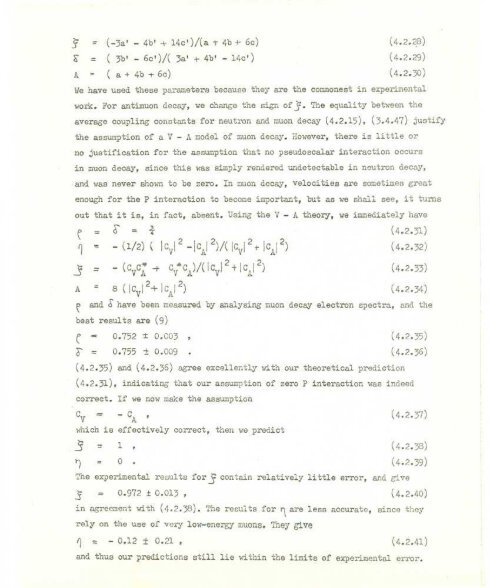introduction-weak-interaction-volume-one
introduction-weak-interaction-volume-one
introduction-weak-interaction-volume-one
Create successful ePaper yourself
Turn your PDF publications into a flip-book with our unique Google optimized e-Paper software.
_ (-3a ' - 4b' + 14c')/(a t 4b + 6c) (4 .2 .28 )<br />
= ( 3b' - 6c')/( 3a' + 4b' - 14c') (4 .2 .7.9 )<br />
A = ( a+ 4b + 6c) (4 .2 .30)<br />
We have used these parameters because they are the comm<strong>one</strong>st in experimental<br />
work . For antimuon decay, we change the sign of . The equality between th e<br />
average coupling constants for neutron and muon decay (4 .2 .15), (3 .4 .47) justify<br />
the assumption of a V - A model of muon decay . However, there is little o r<br />
no justification for the assumption that no pseudoscalar <strong>interaction</strong> occur s<br />
in muon decay, since this was simply rendered undetectable in neutron decay ,<br />
and was never shown to be zero . In muon decay, velocities are sometimes grea t<br />
enough for the P <strong>interaction</strong> to become important, but as we shall see, it turn s<br />
out that it is, in fact, absent . Using the V - A theory, we immediately hav e<br />
e = _ (4 .2 .31 )<br />
9 _ - ( 1 /2) ( lcvl -I c Al 2 )/( 2+ I CA I 2 ) (4 .2 .32 )<br />
= - (cVA - Cv CA )/(ICV 1 2 +l C Al 2 ) (4 .2 .33 )<br />
A 8 (IC V l 2+1C A J 2) (4 .2 .34 )<br />
and E have been measured by analysing muon decay electron spectra, and th e<br />
best results are (9 )<br />
0 .752 t 0 .003 , (4 .2 .35 )<br />
0 .755 ± 0 .009 . (4 .2 .36 )<br />
(4 .2 .35) and (4 .2 .36) agree excellently with our theoretical predictio n<br />
(4 .2 .31), indicating that our assumption of zero P <strong>interaction</strong> was indee d<br />
correct . If we now make the assumptio n<br />
CV = - CA , (4 .2 .37 )<br />
which is effectively correct, then we predict<br />
= 1 ,<br />
(4 .2 .38 )<br />
*~ = 0 . (4 .2 .39 )<br />
The experimental results for_F contain relatively little error, and give<br />
= 0 .972 t 0 .013 , (4 .2 .40 )<br />
in agreement with (4 .2 .38) . The results for rare less accurate, since they<br />
rely on the use of very low-energy muons . They give<br />
- 0 .12 ± 0 .2.1 , (4 .2 .41 )<br />
and thus our predictions still lie within the limits of experimental error.



